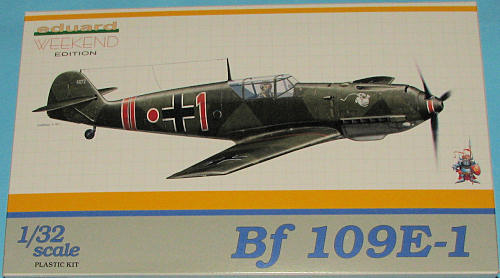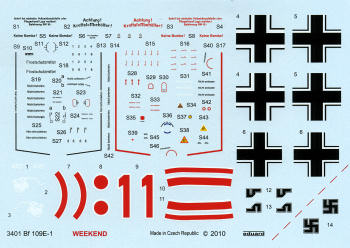Eduard 1/32 Bf-109E-1
|
KIT #: |
3401 |
|
PRICE: |
$39.95 MSRP |
|
DECALS: |
One option |
|
REVIEWER: |
Scott Van Aken |
|
NOTES: |
Weekend Edition |

In late 1938, the "Emil" entered production. To
improve on the performance afforded by the rather small 447-522 kW (600-700 hp)
Jumo, the larger Daimler-Benz DB 601A engine was used, yielding an extra 223 kW
(300 hp) at the cost of an additional 181 kg (400 lb). To test the new 1,100 PS
(1,085 hp, 809 kW) DB601A engine, two more prototypes (V14
and V15)
were built, each differing in their armament. While the V14 was armed with two
7.92 mm (.312 in) MG 17s above the engine and one 20 mm MG FF in each wing, the
V15 was fitted with the two MG 17s mounted above the engine only. After test
fights the V14 was considered more promising and a pre-production batch of 10
E-0
was ordered. Batches of both E-1 and E-3 variants were shipped to Spain for
evaluation, and received their baptism of fire in the final phases of the
Spanish Civil War.
The production version
E-1 (and subject of this kit)
kept two 7.92 mm (.312 in) MG 17s above the engine and two more in the wings.
The E-1B
was a small batch of E-1s becoming the first operational Bf 109 fighter bomber,
or Jagdbomber
(usually abbreviated to Jabo).
These were fitted with either an ETC 250 bomb rack, carrying one 250 kg (550 lb)
bomb, or two ETC 50 bomb racks, each carrying a 50 kg (110 lb) bomb under both
wings. The E-1 was also fitted with the Reflexvisier "Revi" gunsight.
Communications equipment was the FuG 7
Funkgerät 7 (radio set)
short-range radio apparatus, effective to ranges of 48–56 km (30–35 mi). A total
of 1,183 E-1 were built, 110 of them were E-1/B.
The E-1 version was built concurrently with the E-3
cannon armed version at a ratio of 2 E-1s for every 3 E-3s.
 When
the standard kit was released about a year or so back, it was quickly snapped up
by enthusiastic builders. However, for some, the price of $75 retail was a bit
much, despite all the additional goodies provided in that original, Profipak
release. For a number of modelers, photo-etch, resin parts and extensive wheel
and canopy masks are just additional bits that are not needed to build a model.
When
the standard kit was released about a year or so back, it was quickly snapped up
by enthusiastic builders. However, for some, the price of $75 retail was a bit
much, despite all the additional goodies provided in that original, Profipak
release. For a number of modelers, photo-etch, resin parts and extensive wheel
and canopy masks are just additional bits that are not needed to build a model.
Fortunately, one only has to wait a while and Eduard ends up releasing a kit
without all the extra bits as a Weekend Edition. This kit still has the full
engine and all the cockpit detail of the earlier boxing, albeit in plastic
without enhancements. One thing I miss is not having etched seat belts, but
those should be easy enough to locate. It would have been nice to have at least
a decal for the instrument panel as the kit's instrument faces are blank.
While the kit does come with a full engine, the builder has the option of not
including it in the model, thus shortening build time. One does, however, have
to make a choice rather early as the same individual exhaust stacks are used for
both options. The kit provides separate flight control surfaces. Only the flaps
seem to be able to be positioned in something other than the neutral position.
Cutting the tabs on the other parts might allow them to be posed differently.
The kit also has separate slats which can be posed extended and should be.

I should mention that it seems Eduard did do the proper wings for an E-1
as there are no holes for cannon bulges under the wings as on the E-3/4/7
versions. The kit does come with a drop tank which isn't applicable for an E-1
as the planes were not plumbed for it, so leave it off. There is also canopy
head armor included that isn't appropriate for the decals that come in the kit,
so leave that off as well. Most 109s didn't start using it until around the
middle of 1940.
Instructions are well done with Gunze, generic and RLM color references. The
lone markings (one of the trademarks of the Weekend Editions), are for Hannes
Trautloft's plane in September 1939 when with 2./JG 77. It is in the standard
RLM 70/71/65 splinter camo with a low demarcation line. The decal and painting
guide is somewhat indistinct between the two upper colors, but the same info is
on the box. To me, the reds in the decal sheet are far too bright, but the sheet
itself is well printed with full data markings and a well done placement guide
in the instructions.
If you don't have deep enough pockets for the standard boxing, then this is the
one to get.
I'm pleased to see this one come out and at nearly half price of the
original boxing, I can do without the additional bits along with a reduced
markings option. Most of us have a fret or two of seat harnesses anyway and
many of us normally choose markings not provided in the kit. I have to tell
you that I was waiting for this one to come out and am glad I held off. So
is my wallet.
Bought by me and I paid retail!
October 2010
If you would like your product reviewed fairly and quickly, please
contact
me or see other details in the
Note to
Contributors.
Back to the Main Page
Back to the Previews Index Page


 When
the standard kit was released about a year or so back, it was quickly snapped up
by enthusiastic builders. However, for some, the price of $75 retail was a bit
much, despite all the additional goodies provided in that original, Profipak
release. For a number of modelers, photo-etch, resin parts and extensive wheel
and canopy masks are just additional bits that are not needed to build a model.
When
the standard kit was released about a year or so back, it was quickly snapped up
by enthusiastic builders. However, for some, the price of $75 retail was a bit
much, despite all the additional goodies provided in that original, Profipak
release. For a number of modelers, photo-etch, resin parts and extensive wheel
and canopy masks are just additional bits that are not needed to build a model.
